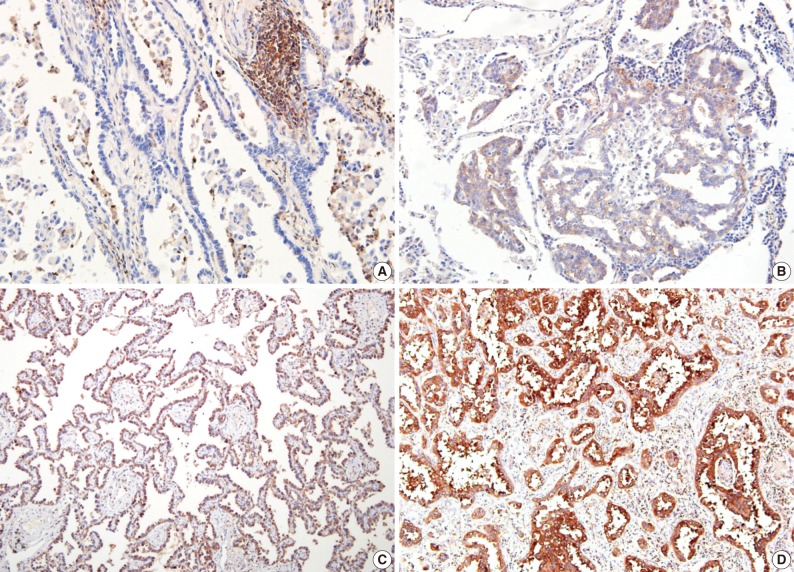Articles
- Page Path
- HOME > J Pathol Transl Med > Volume 46(5); 2012 > Article
-
Original Article
Clinicopathologic Implication of Ezrin Expression in Non-small Cell Lung Cancer - Ho Won Lee, Eui Han Kim, Mee-Hye Oh
-
Korean Journal of Pathology 2012;46(5):470-477.
DOI: https://doi.org/10.4132/KoreanJPathol.2012.46.5.470
Published online: October 25, 2012
Department of Pathology, Soonchunhyang University College of Medicine, Cheonan, Korea.
- Corresponding Author: Mee-Hye Oh, M.D. Department of Pathology, Soonchunhyang University College of Medicine, 31 Suncheonhyang 6-gil, Dongnam-gu, Cheonan 330-721, Korea. Tel: +82-41-570-3582, Fax: +82-41-570-2455, mhoh0212@hanmail.net
© 2012 The Korean Society of Pathologists/The Korean Society for Cytopathology
This is an Open Access article distributed under the terms of the Creative Commons Attribution Non-Commercial License (http://creativecommons.org/licenses/by-nc/3.0) which permits unrestricted non-commercial use, distribution, and reproduction in any medium, provided the original work is properly cited.
Abstract
-
Background
- Ezrin, a member of the ezrin-radixin-moesin family, is implicated in tumor progression, metastatic dissemination, and adverse outcomes, in several cancer types. In this study, we explored the clinicopathological significance of ezrin expression in non-small cell lung carcinomas (NSCLCs).
-
Methods
- Immunohistochemical analysis of tissue microarray with 112 surgically resected NSCLC specimens, was performed to examine the ezrin expression. We also correlated ezrin expression with other clinicopathological features and prognosis.
-
Results
- The ezrin-positive group revealed significantly higher correlation with pleural invasion (p=0.016) and pathologic stage (p=0.050). Univariate survival analysis showed that ezrin-positive group had a significantly shorter cancer-specific survival than ezrin-negative group (p=0.016). Meanwhile, female (p=0.030), no pleural invasion (p=0.023), no lymphatic invasion (p=0.026), and early pathologic stage (p=0.008) significantly correlated with longer survival. Multivariate survival analysis showed that variables such as ezrin positivity (p=0.032), female (p=0.035), and early pathologic stage (p=0.001) were independent prognostic factors for NSCLC.
-
Conclusions
- Ezrin might be a molecular marker to predict poor prognosis of NSCLC.
- Patients and tissues
- We retrospectively obtained formalin-fixed and paraffin-embedded tissues from 112 resected primary NSCLC cases, which were obtained from the Soonchunhyang University Cheonan Hospital, between January 1996 and October 2009. Tumors from patients who died from causes other than lung carcinoma and recurrent or metastatic tumors were excluded from this study. The patients with NSCLC consisted of 81 men and 31 women. The mean patient age was 63 years (standard deviation, 8.0; range, 42 to 82 years), and the mean tumor size was 3.8 cm (standard deviation 1.9; range, 1.0 to 8.6 cm).
- Hematoxylin and eosin (H&E) stained slides were reviewed for each case to confirm the original diagnosis. Two pathologists (M.H.Oh and H.W.Lee) independently reviewed these slides based on the World Health Organization criteria,22 to select the most representative sections. Tumor specimens were histopathologically diagnosed as adenocarcinoma (ADC; n=38), squamous cell carcinoma (SCC; n=59), large cell carcinoma (n=1), large cell neuroendocrine carcinoma (n=6), and sarcomatoid carcinoma (n=8). The pathologic stage of each tumor was assigned, following the guidelines from the 7th edition of tumor-node-metastasis (TNM) classification.23 The total sample set comprised of 57 stage I, 38 stage II, 13 stage III, and 4 stage IV tumors. The patients' medical records were collected to obtain the following information: age, gender, and smoking status. Further data regarding the patients' survival status and cause of death were obtained from the patients' medical records and/or from an interview with the family. The median follow-up period for all patients was 23.0 months, with a range of 1 to 153 months.
- Construction of tissue microarray (TMA)
- The most representative tumor area was carefully marked on H&E stained slides of the sample tissue cores (2 mm in diameter) from formalin fixed, paraffin embedded tissue blocks. Representative cores were arranged in a trephine apparatus (Superbiochips Laboratories, Seoul, Korea). Core sample was obtained from each tumor and included in the TMA block. Control or normal parenchymal cores were also included. Some tumor cores contained non-neoplastic portion and they were used as internal control. One section from the block was stained with H&E for tissue confirmation.
- Immunohistochemistry (IHC) for ezrin
- IHC was performed to analyze ezrin expression. The materials and methods used in this study have been described previously.11,24,25 Sections (4-µm thick) from the TMA blocks were transferred to poly-L-lysine-coated glass slides and incubated in a dry oven, at 60℃ for 1 hour. Therefore, they were then dewaxed in xylene (three changes), rehydrated in a graded series of decreasing ethanol concentrations and rinsed in Tris-buffered saline (pH 7.4). Endogenous peroxidase activity was inactivated with 5% hydrogen peroxide in methanol for 15 minutes at 37℃. For ezrin staining, antigen retrieval was performed using a microwave treatment in the pH 6.0-epitope retrieval solution for 20 minutes. The tissue was incubated with a mouse monoclonal antibody against ezrin (1:100, clone 3C12, Abcam, Cambridge, UK) in a humidified chamber at 4℃ for 16 hours. Secondary antibody was applied, using a Bond polymer refine detection kit (Leica, Mount Waverley, Australia). Diaminobenzidine was used, as the chromogen, and the sections were counterstained with Mayer's hematoxylin. Positive controls, consisting of cases with known reactivity for the antibody, and negative controls, obtained by omitting the primary antibody, were also included.
- Immunohistochemical assessment
- Tumor cells were judged as positive if cytoplasmic and circumferential membranous staining were present. Immunohistochemical staining was separately evaluated by two investigators (M.H.Oh and H.W.Lee), and in the rare instance of a discrepancy between their judgment, they reviewed the slides together using a multi-head microscope. A semiquantitative immunohistochemical score was assigned, which included assessment of both intensity and extent of staining. Intensity of staining was given score of 0 to 3 (corresponding to negative, weak, moderate, and strong positivity). The extent of staining was scored as 0 (0%), 1 (1-10%), 2 (11-50%), and 3 (51-100%), according to the percentage of cells which stained positive for each protein. The product of intensity and extent score was used as the final score (0, 1, 2, 3, 4, 6, 9). Tissues having a final score of 9 were considered positive, while those having a final score of ≤6 were regarded as negative. Similar semiquantitative scoring systems have been successfully used for other TMA evaluations.25
- Statistical analysis
- Statistical anlaysis was conducted using SPSS ver. 14.0 (SPSS Inc., Chicago, IL, USA). Associations between the ezrin expression and the clinicopathological characteristics were analyzed, using the Pearson χ2 or Fisher's exact test. Kaplan-Meier analysis was performed for analysis of the survival curves and statistical significance was assessed using the log-rank test. Cancer-specific survival was defined as the time from the date of the surgery to the last follow-up visit or cancer-related death. Univariate analysis of cancer-specific survival was performed using the Kaplan-Meier method. Multivariate Cox proportional hazard regression analysis was used to assess the prognostic significance between ezrin expression, the other clinicopathological characteristics, and survival. Overall, 95% confidence intervals were used throughout the analyses. Statistical significance was defined as p<0.05.
MATERIALS AND METHODS
- Ezrin immunoreactivity
- In the non-neoplastic pulmonary parenchyma, ezrin was expressed in the apical membrane of the bronchial epithelium and in the pneumocytes of the alveolar wall and inflammatory cells, including lymphocytes and plasma cells. Ezrin in NSCLC appeared mainly in the cytoplasm and circumferential membrane (Figs. 1, 2). Regarding intensity of staining, 8 cases (7.1%) were scored as 0, 27 cases (24.1%) as 1, 41 cases (36.6%) as 2, and 36 cases (32.2%) as 3. Regarding extent of staining, 8 cases (7.1%) were rated as 0, 0 case (0%) as 1, 3 cases (2.7%) as 2, and 101 cases (90.2%) as 3. As mentioned above, ezrin expression in NSCLC showed a diffuse staining pattern. After multiplying staining intensity and extent scores of the 112 immunostained NSCLC specimens, 8 cases (7.1%) were rated as 0, 3 cases (2.7%) as 2, 27 cases (24.1%) as 3, 0 case (0%) as 4, 41 cases (36.6%) as 6, and 33 (29.5%) as 9. The cases were subdivided into ezrin-negative groups (scores of 0, 2, 3, and 6; n=79 [70.5%]) and ezrin-positive group (scores of 9; n=33 [29.5%]) for statistical analysis.
- Correlations between Ezrin expression and clinicopathologic parameters
- The expression of ezrin was significantly higher in the tumors with pleural invasion and late pathologic stage. A weak correlation between ezrin expression and T status was also found. Other clinicopathologic variables, including sex, age, tumor size, histological type, smoking, lymphatic invasion, perineural invasion, nodal status, and metastasis, showed no correlation with ezrin expression (Table 1). Although we did not include adenocarcinoma in situ (formerly bronchioloalveolar carcinoma) for analysis in case of ADC, portions of adenocarcinoma in situ showed negativity (Fig. 1A).
- Survival analysis
- At the time of analysis, the number of cancer-specific deaths was 64 (57.1%). Ezrin expression, age, sex, histological type, smoking status, tumor size, pleural invasion, lymphatic invasion, perineural invasion, tumor status and nodal status of TNM, as well as pathologic stage were included in the univariate analysis to evaluate significance of each variable upon cancer-specific survival (Table 2). Ezrin positive groups (see above) displayed a significantly shorter cancer-specific survival than ezrin negative groups (p=0.016) (Fig. 3). Among the above-mentioned variables, female (p=0.030), no pleural invasion (p=0.023), no lymphatic invasion (p=0.026), and early pathologic stage (p=0.008) correlated significantly with longer survival (Table 2). To evaluate whether ezrin positivity in NSCLC is an independent predictor of cancer-specific survival, a multivariate analysis using the Cox proportional hazard model, was performed. This analysis included the variables ezrin expression, sex, pleural invasion, venous lymphatic invasion, and pathologic stage. All variables with a p<0.05 in a univariate analysis were included in a multivariate Cox model. Ezrin positivity (p=0.032), male (p=0.035), and late pathologic stage (p=0.001) were significantly poor prognostic factors for NSCLC. Multivariate analysis demonstrated that ezrin expression was an independent prognostic factor for cancer-specific survival (Table 3).
RESULTS
- Following the purification of ezrin as a component of the intestinal microvilli that is tyrosine-phosphorylated, by epidermal growth factor,26 many studies have been focused on the relationship between malignant tumors and tumor invasiveness or related outcomes. Recently, many studies have suggested that increased ezrin expression was associated with poor outcome in various types of cancers, in various organs, including gastric carcinoma,7 colorectal carcinoma,8,9 nasopharyngeal carcinoma,10 esophageal SCC,11 breast carcinoma,12 osteosarcoma,13,14 various soft tissue sarcomas,15,16 cutaneous basal cell carcinoma and SCC,17 and melanoma.18 Some cohort studies19,21 suggested the distinct fuction of ezrin in tumor cell invasion or metastasis, however, no report to date has ever identified its favorable prognostic value. In this study, we analyzed the relationship between ezrin expression and clinicopathological parameters as well as survival. We observed that increased ezrin expression correlated with pleural invasion (p=0.016), tumor stage (p=0.050), and shorter survival (p=0.016). However, ezrin expression did not correlate with other clinicopathological parameters, such as sex, age, tumor size, histology, smoking, lymphatic invasion, perineural invasion, tumor status, nodal status, and metastasis.
- Although the association of ezrin with tumor proliferation and invasiveness was confirmed in several types of cancers, the exact mechanism has not yet been defined. Hiscox and Jiang27 and McClatchey28 insisted that the metastatic process begins with a breakdown of the epithelial integrity causing the tumor cells to penetrate into the vascular system, where they finally obtains aggressive proliferation in appropriate target organs. Cell adhesion molecules and actin cytoskeleton play important roles during these processes. Khanna et al.13 and Fiévet et al.29 suggested that ezrin participated in invasiveness and metastasis processes believed to be predominantly late events in tumor progression. Interestingly, our study revealed that ezrin expression correlated to higher tumor stage (p=0.050), and bronchioloalveolar portion of ADC showed a trend of ezrin negativity.
- Further elucidation of the molecular mechanisms underlying lung cancer progression is essential for the development of new effective therapeutic agents. Recent strategies include personalized treatment selecting those patients that are likely to respond to a particular chemotherapeutic regimen. Such approach may contribute to improved treatment efficacy while avoiding unnecessary side effects. With regard to the potential therapeutic use of ezrin, several possible approaches can be exploited such as the development of an antibody or an inhibitor of ezrin or its downstream molecules. Active researches are ongoing to identify such molecules. Previous studies have elucidated that the metastatic behavior of ezrin is related to the mTOR signaling pathway. Blocking this pathway has been shown to inhibit experimental lung metastasis. Currently, the mTOR inhibitor rapamycin and its analogues are being appraised in preclinical and clinical trials for the treatment of cancer.9,30 In this study, we used IHC to analyze the levels of ezrin expression in 112 clinicopathologically characterized NSCLC cases. In normal non-neoplastic tissue, ezrin was expressed in the apical portion of bronchial epithelium and pneumocytes. In malignant tumors, however, ezrin showed diffuse cytoplasm and circumferential membranous staining pattern. Wan et al.30 reported that in invasive breast tumors and cancer cell lines, switching the localization of ezrin from the apical membrane to either the complete membrane, or to the cytoplasm was correlated with dediffentiation and adverse features. In the present study, we found that ezrin expression in NSCLC showed a diffuse staining pattern, such that scores mainly correlated with the staining intensity but not staining extent. Abdou et al.17 have erstwhile suggested that intensity, rather than extent of ezrin expression, had a more probable impact on tumor behavior. At any rate, however, it is necessary to establish detailed and standardized immunohistochemical assessment of ezrin expression. Another important finding of our study is the consistently significant relationship between survival and ezrin expression in both univariate (p=0.016) and multivariate analyses (p=0.032). It indicates that ezrin might be a new molecular marker to predict the prognosis of NSCLC.
- Despite providing new insights into the relationship between ezrin expression and clinical outcome in NSCLC, the present study has some limitations which restrict generalization of our results. For instance, we cannot exclude that selection bias could have influenced our findings because all of the enrolled patients were surgically resectable. Furthermore, our study is retrospective and included only one TMA core per case. It is of note, however, that several recent studies used the same methods we have applied herein such as scoring system and TMA block.7,11,15,16 Nevetheless, the present findings remain to be confirmed by further studies. Moreover, the value of ezrin as an independent predictor of NSCLC necessitates further multivariate analysis especially in a larger cohort of patients.
- In summary, we have demonstrated that ezrin expression is associated with poor prognostic outcome in NSCLC and is higher in late stage tumors and those with pleural invasion. In view of these findings, it is suggested that ezrin might be a new molecular marker to predict the prognosis of NSCLC.
DISCUSSION
Acknowledgments
Acknowledgments
- 1. Jemal A, Siegel R, Ward E, Murray T, Xu J, Thun MJ. Cancer statistics, 2007. CA Cancer J Clin 2007; 57: 43-66. ArticlePubMed
- 2. Tsuchiya T, Akamine S, Muraoka M, et al. Stage IA non-small cell lung cancer: vessel invasion is a poor prognostic factor and a new target of adjuvant chemotherapy. Lung Cancer 2007; 56: 341-348. ArticlePubMed
- 3. Bretscher A, Edwards K, Fehon RG. ERM proteins and merlin: integrators at the cell cortex. Nat Rev Mol Cell Biol 2002; 3: 586-599. ArticlePubMedPDF
- 4. Hunter KW. Ezrin, a key component in tumor metastasis. Trends Mol Med 2004; 10: 201-204. ArticlePubMed
- 5. Brambilla D, Fais S. The Janus-faced role of Ezrin in "linking" cells to either normal or metastatic phenotype. Int J Cancer 2009; 125: 2239-2245. ArticlePubMed
- 6. Bruce B, Khanna G, Ren L, et al. Expression of the cytoskeleton linker protein ezrin in human cancers. Clin Exp Metastasis 2007; 24: 69-78. ArticlePubMedPDF
- 7. Zhao J, Zhang X, Xin Y. Up-regulated expression of ezrin and c-Met proteins are related to the metastasis and prognosis of gastric carcinomas. Histol Histopathol 2011; 26: 1111-1120. PubMed
- 8. Elzagheid A, Korkeila E, Bendardaf R, et al. Intense cytoplasmic ezrin immunoreactivity predicts poor survival in colorectal cancer. Hum Pathol 2008; 39: 1737-1743. ArticlePubMed
- 9. Korkeila EA, Syrjänen K, Bendardaf R, et al. Preoperative radiotherapy modulates ezrin expression and its value as a predictive marker in patients with rectal cancer. Hum Pathol 2011; 42: 384-392. ArticlePubMed
- 10. Wang L, Lin GN, Jiang XL, Lu Y. Expression of ezrin correlates with poor prognosis of nasopharyngeal carcinoma. Tumour Biol 2011; 32: 707-712. ArticlePubMedPDF
- 11. Xie JJ, Xu LY, Wu ZY, et al. Prognostic implication of ezrin expression in esophageal squamous cell carcinoma. J Surg Oncol 2011; 104: 538-543. ArticlePubMed
- 12. Elliott BE, Meens JA, SenGupta SK, Louvard D, Arpin M. The membrane cytoskeletal crosslinker ezrin is required for metastasis of breast carcinoma cells. Breast Cancer Res 2005; 7: R365-R373. ArticlePubMedPMCPDF
- 13. Khanna C, Wan X, Bose S, et al. The membrane-cytoskeleton linker ezrin is necessary for osteosarcoma metastasis. Nat Med 2004; 10: 182-186. ArticlePubMedPDF
- 14. Kim C, Shin E, Hong S, et al. Clinical value of ezrin expression in primary osteosarcoma. Cancer Res Treat 2009; 41: 138-144. ArticlePubMedPMC
- 15. Lee JS, Jin MS, Lee JE, Kim MS, Jeon DG, Koh JS. Prognostic significance of ezrin expression in liposarcoma. Korean J Pathol 2008; 42: 270-276.
- 16. Carneiro A, Bendahl PO, Åkerman M, et al. Ezrin expression predicts local recurrence and development of metastases in soft tissue sarcomas. J Clin Pathol 2011; 64: 689-694. ArticlePubMed
- 17. Abdou AG, Maraee AH, El-Sayed EM, Elnaidany NF. Immunohistochemical expression of ezrin in cutaneous basal and squamous cell carcinomas. Ann Diagn Pathol 2011; 15: 394-401. ArticlePubMed
- 18. Federici C, Brambilla D, Lozupone F, et al. Pleiotropic function of ezrin in human metastatic melanomas. Int J Cancer 2009; 124: 2804-2812. ArticlePubMed
- 19. Tokunou M, Niki T, Saitoh Y, Imamura H, Sakamoto M, Hirohashi S. Altered expression of the ERM proteins in lung adenocarcinoma. Lab Invest 2000; 80: 1643-1650. ArticlePubMedPDF
- 20. Deng X, Tannehill-Gregg SH, Nadella MV, et al. Parathyroid hormone-related protein and ezrin are up-regulated in human lung cancer bone metastases. Clin Exp Metastasis 2007; 24: 107-119. ArticlePubMedPDF
- 21. Wang J, Zhang M, Chen L, Huang W, Ma H. Expression and correlation of ezrin and survivin in non-small cell lung cancer. Chinese-German J Clin Oncol 2010; 9: 381-384. ArticlePDF
- 22. Travis WD, Brambilla E, Müller-Hermelink K, Harris CC. World Health Organization classification of tumours: pathology and genetics of tumours of the lung, pleura, thymus and heart. 2004; Lyon: IARC Press, 10.
- 23. Travis WD. IASLC Staging Committee. Reporting lung cancer pathology specimens. Impact of the anticipated 7th edition TNM classification based on recommendations of the IASLC Staging Committee. Histopathology 2009; 54: 3-11. ArticlePubMed
- 24. Patara M, Santos EM, Coudry Rde A, Soares FA, Ferreira FO, Rossi BM. Ezrin expression as a prognostic marker in colorectal adenocarcinoma. Pathol Oncol Res 2011; 17: 827-833. ArticlePubMedPDF
- 25. Jung EA, Cho HD, Lee JH, Oh MH. Clinicopathological significance of S100A4 expression in non-small cell lung carcinomas. Korean J Pathol 2010; 44: 477-482. Article
- 26. Bretscher A. Rapid phosphorylation and reorganization of ezrin and spectrin accompany morphological changes induced in A-431 cells by epidermal growth factor. J Cell Biol 1989; 108: 921-930. ArticlePubMedPMCPDF
- 27. Hiscox S, Jiang WG. Ezrin regulates cell-cell and cell-matrix adhesion, a possible role with E-cadherin/beta-catenin. J Cell Sci 1999; 112(Pt 18):3081-3090. PubMedPDF
- 28. McClatchey AI. Merlin and ERM proteins: unappreciated roles in cancer development? Nat Rev Cancer 2003; 3: 877-883. ArticlePubMedPDF
- 29. Fiévet B, Louvard D, Arpin M. ERM proteins in epithelial cell organization and functions. Biochim Biophys Acta 2007; 1773: 653-660. ArticlePubMed
- 30. Wan X, Mendoza A, Khanna C, Helman LJ. Rapamycin inhibits ezrin-mediated metastatic behavior in a murine model of osteosarcoma. Cancer Res 2005; 65: 2406-2411. ArticlePubMedPDF
REFERENCES

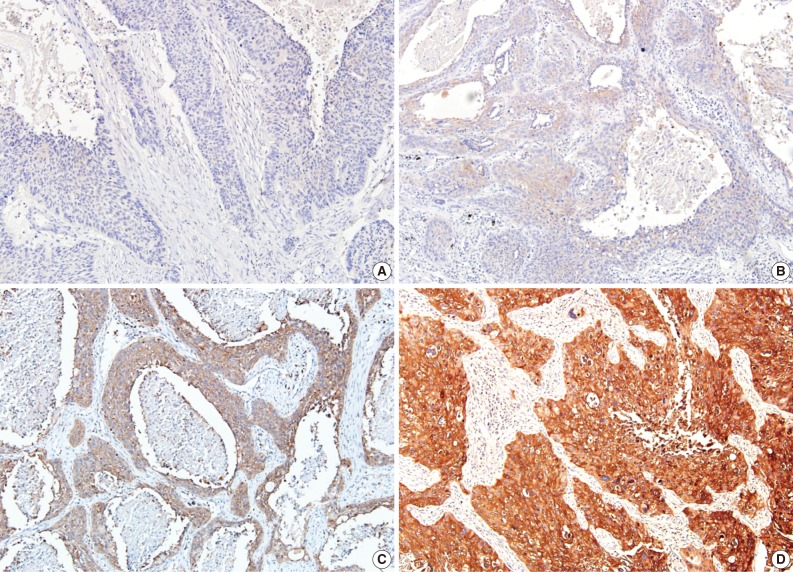

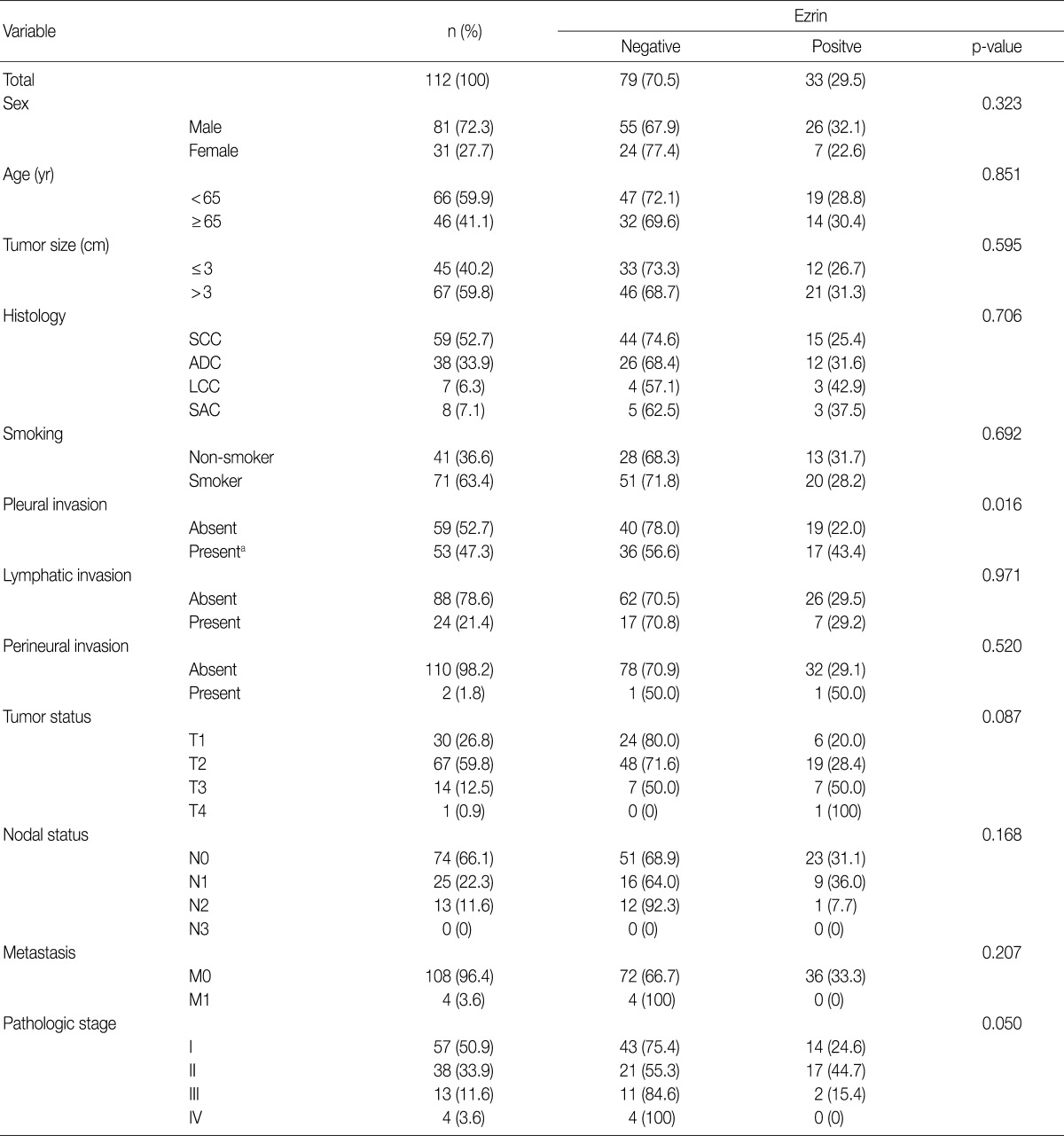
Figure & Data
References
Citations

- Immunoexpression of E-cadherin, β-catenin and Ezrin in non-small cell lung carcinomas
Daniela Florentina Grecu, Bianca Cătălina Andreiana , Claudiu Mărgăritescu , Alexandru Florian Grecu , Marian Valentin Zorilă , Daniela Marinescu , Alex Emilian Stepan
Romanian Journal of Morphology and Embryology.2025; 65(4): 661. CrossRef - Perspectives for Targeting Ezrin in Cancer Development and Progression
Jean Carlos Lipreri da Silva, Hugo Passos Vicari, João Agostinho Machado-Neto
Future Pharmacology.2023; 3(1): 61. CrossRef - CIGB-300 Anticancer Peptide Differentially Interacts with CK2 Subunits and Regulates Specific Signaling Mediators in a Highly Sensitive Large Cell Lung Carcinoma Cell Model
George V. Pérez, Mauro Rosales, Ailyn C. Ramón, Arielis Rodríguez-Ulloa, Vladimir Besada, Luis J. González, Daylen Aguilar, Dania Vázquez-Blomquist, Viviana Falcón, Evelin Caballero, Paulo C. Carvalho, Rodrigo Soares Caldeira, Ke Yang, Yasser Perera, Silv
Biomedicines.2022; 11(1): 43. CrossRef - Increased Tumor Growth Rate and Mesenchymal Properties of NSCLC-Patient-Derived Xenograft Models during Serial Transplantation
José Miguel Pardo-Sánchez, Nuria Mancheño, José Cerón, Carlos Jordá, Emilio Ansotegui, Óscar Juan, Sarai Palanca, Antonio Cremades, Carolina Gandía, Rosa Farràs
Cancers.2021; 13(12): 2980. CrossRef - Loss of ARID1A expression is associated with poor prognosis in non-small cell lung cancer
Si-Hyong Jang, Ji-Hye Lee, Hyun Ju Lee, Hyundeuk Cho, Hyein Ahn, In Hag Song, Mee-Hye Oh
Pathology - Research and Practice.2020; 216(11): 153156. CrossRef - Ezrin Mediates Invasion and Metastasis in Tumorigenesis: A Review
Yanan Song, Xiaokun Ma, Miao Zhang, Menghan Wang, Guoyu Wang, Ying Ye, Wei Xia
Frontiers in Cell and Developmental Biology.2020;[Epub] CrossRef - Correlation of Ezrin Expression Pattern and Clinical Outcomes in Ewing Sarcoma
Thomas Cash, Hong Yin, Courtney McCracken, Zhi Geng, Steven G. DuBois, Bahig M. Shehata, Thomas A. Olson, Howard M. Katzenstein, Cynthia Wetmore
Sarcoma.2017; 2017: 1. CrossRef - Prognostic and Clinicopathological Significance of Transducer-Like Enhancer of Split 1 Expression in Gastric Cancer
Ji-Hye Lee, Myoung-Won Son, Kyung-Ju Kim, Mee-Hye Oh, Hyundeuk Cho, Hyun Ju Lee, Si-Hyong Jang, Moon Soo Lee
Journal of Gastric Cancer.2016; 16(1): 21. CrossRef - Significance of DEK overexpression for the prognostic evaluation of non-small cell lung carcinoma
XIN LIU, DONGDONG QI, JUJIE QI, ZESHU MAO, XIANGDAN LI, JINHUI ZHANG, JINZI LI, WENBIN GAO
Oncology Reports.2016; 35(1): 155. CrossRef - Silencing of high‐mobility group box 2 (HMGB2) modulates cisplatin and 5‐fluorouracil sensitivity in head and neck squamous cell carcinoma
Nazia Syed, Sandip Chavan, Nandini A. Sahasrabuddhe, Santosh Renuse, Gajanan Sathe, Vishalakshi Nanjappa, Aneesha Radhakrishnan, Remya Raja, Sneha M. Pinto, Anand Srinivasan, T. S. Keshava Prasad, Kotteazeth Srikumar, Harsha Gowda, Vani Santosh, David Sid
PROTEOMICS.2015; 15(2-3): 383. CrossRef - Prognostic Value of Ezrin in Various Cancers: A Systematic Review and Updated Meta-analysis
Jianwei Li, Kuanhai Wei, Hailang Yu, Dan Jin, Gang Wang, Bin Yu
Scientific Reports.2015;[Epub] CrossRef - Radixin Enhances Colon Cancer Cell Invasion by Increasing MMP-7 Production via Rac1-ERK Pathway
Qi-Hong Jiang, Ai-Xiang Wang, Yan Chen
The Scientific World Journal.2014; 2014: 1. CrossRef - Clinical significance of microRNA-183/Ezrin axis in judging the prognosis of patients with osteosarcoma
Yisila Mu, Haoshaqiang Zhang, Lixin Che, Kun Li
Medical Oncology.2014;[Epub] CrossRef - Prognostic implications of ezrin and phosphorylated ezrin expression in non-small cell lung cancer
Tiefeng Jin, Jingchun Jin, Xiangyu Li, Songnan Zhang, Yun Ho Choi, Yingshi Piao, Xionghu Shen, Zhenhua Lin
BMC Cancer.2014;[Epub] CrossRef - Prognostic Value of Ezrin in Solid Tumors: A Meta-Analysis of the Literature
Kun Han, WeiXiang Qi, ZhiHua Gan, Zan Shen, Yang Yao, DaLiu Min, Yves St-Pierre
PLoS ONE.2013; 8(7): e68527. CrossRef



Fig. 1
Fig. 2
Fig. 3



NSCLC, non-small cell lung carcinoma; SCC, squamous cell carcinoma; ADC, adenocarcinoma; LCC, large cell carcinoma; SAC, sarcomatoid carcinoma. aVisceral and/or parietal invasion.
NSCLC, non-small cell lung carinoma; ADC, adenocarcinoma; SCC, squamous cell carcinoma; LCC, large cell carcinoma; STC, sarcomatoid carcinoma. aAbsent vs present.
NSCLC, non-small cell lung carinoma; HR, hazard ratio; CI, confidence interval. aAbsent vs present.

 E-submission
E-submission
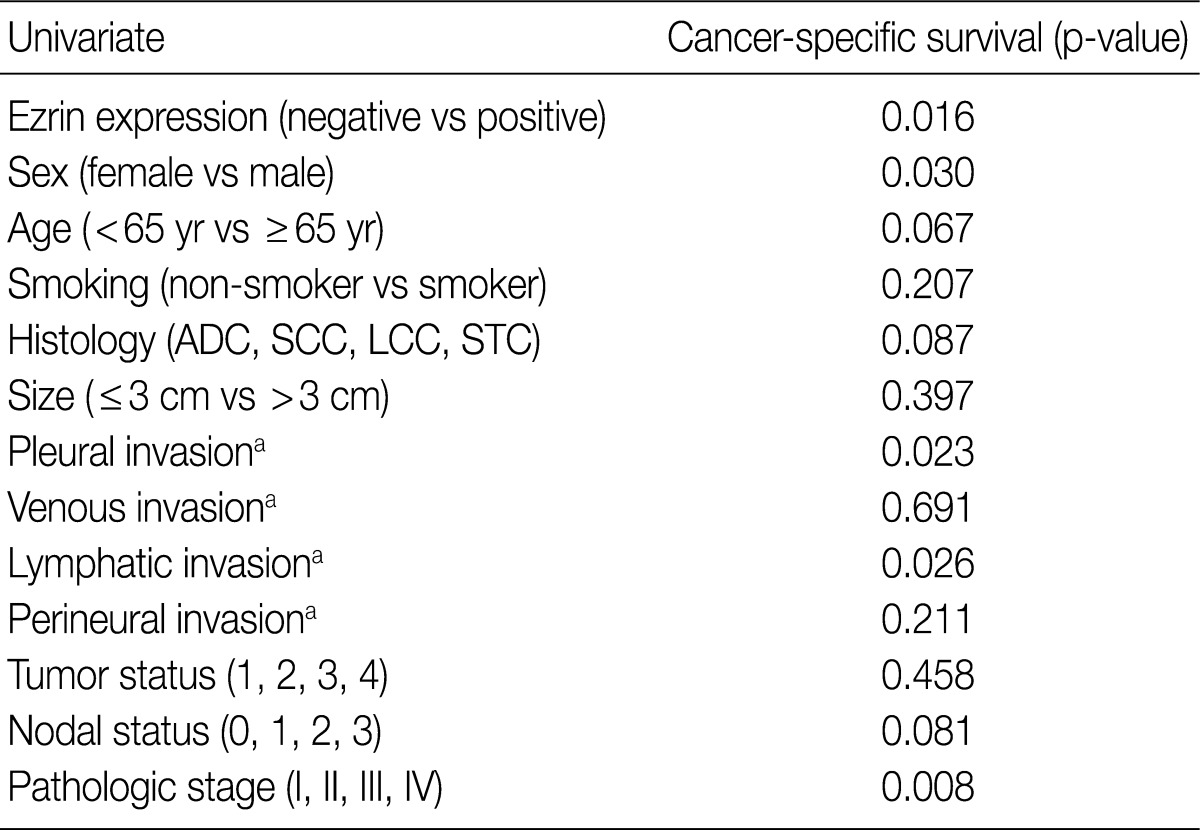
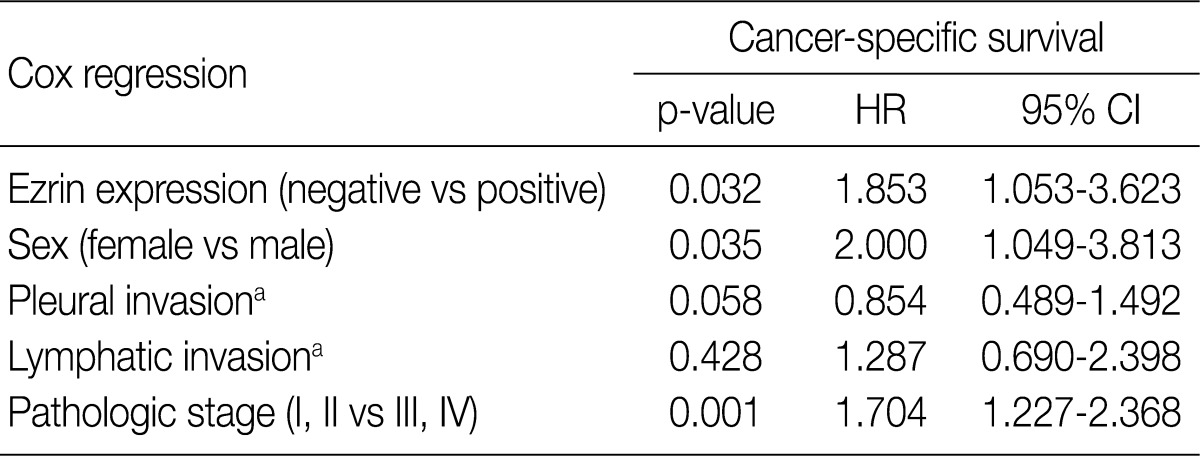
 PubReader
PubReader Cite this Article
Cite this Article